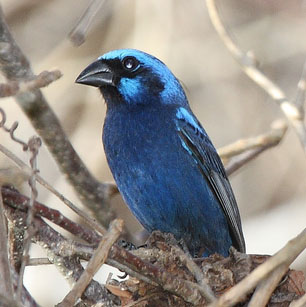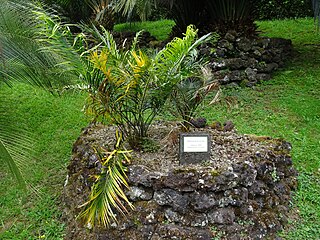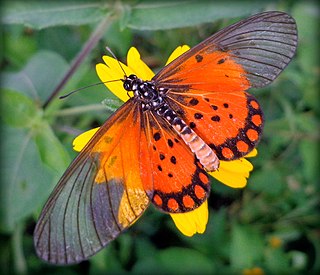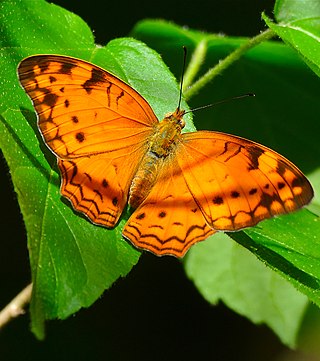
The red-chested swallow is a small non-migratory passerine bird found in West Africa, the Congo Basin and Ethiopia. It has a long, deeply forked tail and curved, pointed wings.

Gymnanthes lucida, commonly known as shiny oysterwood or crabwood, is a species of flowering plant in the spurge family, Euphorbiaceae, that is native to southern Florida in the United States, the Bahamas, the Caribbean, Mexico, and Central America.

Salix lucida, the shining willow, Pacific willow, red willow, or whiplash willow, is a species of willow native to northern and western North America, occurring in wetland habitats. It is the largest willow found in British Columbia.

The blue bunting is a species of passerine in the family Cardinalidae, the cardinals or cardinal grosbeaks. It is found in Belize, El Salvador, Guatemala, Honduras, Mexico, and Nicaragua.
Podocarpus hispaniolensis is a species of conifer in the family Podocarpaceae. It is endemic to the Dominican Republic.
Alphonsea lucida is a species of plant in the family Annonaceae. It is endemic to Peninsular Malaysia.
Klarobelia lucida is a species of plant in the Annonaceae family. It is endemic to Ecuador. Its natural habitat is subtropical or tropical dry forests. It is threatened by habitat loss.

Macrozamia lucida is a species of plant in the family Zamiaceae. It is endemic to Australia.
Meryta lucida is a species of plant in the family Araliaceae. It is endemic to the islands of Raiatea and Huahine in the Society Islands of French Polynesia.
Parashorea lucida is a species of plant in the family Dipterocarpaceae. The name lucida is derived from Latin and refers to the venation on the leaf. It is a tall emergent tree, up to 60 m tall, found in mixed dipterocarp forest on clay and clay soils. It is found in Sumatra and Borneo. It is threatened by habitat loss.
Rawsonia burtt-davyi is a species of plant in the Achariaceae family. It is endemic to Malawi.
Tristaniopsis lucida is a species of plant in the family Myrtaceae. It is endemic to New Caledonia.

Cymothoe caenis, the common glider, is a species of butterfly of the family Nymphalidae. It is found in Guinea, Sierra Leone, Liberia, Ivory Coast, Ghana, Togo, southern Nigeria, Cameroon, the Republic of the Congo, the Central African Republic, Angola, the Democratic Republic of the Congo, Uganda, Tanzania and Zambia. The habitat consists of forests and heavy woodland. It is a migratory species.
As of July 2016, the International Union for Conservation of Nature (IUCN) lists 238 conservation dependent species. 0.29% of all evaluated species are listed as conservation dependent. The IUCN also lists seven subspecies and five varieties as conservation dependent.

Acraea boopis, the rainforest acraea, is a butterfly of the family Nymphalidae. It is found in KwaZulu-Natal, Eswatini, from Mozambique to Kenya and in Tanzania.

Lachnoptera ayresii, the eastern blotched leopard, is a butterfly of the family Nymphalidae. It is found in Afromontane and riverine forest from Port St. Johns in the Eastern Cape and then along the escarpment to the midlands of KwaZulu-Natal, Eswatini, Mpumalanga and the Wolkberg in Limpopo, north to Zimbabwe and Mozambique.
Blastobasis chuka is a moth in the family Blastobasidae. It is found in Kenya, where it is known from the south-eastern coast and the central highlands.
Poeciliopsis lucida, the clearfin livebearer, is a species of small freshwater fish in the family Poeciliidae. Reproduction is viviparous, and the female can have several clutches of young developing internally at the same time. It is one of several species of small livebearing fish endemic to Mexico that were described in 1960 by the American ichthyologist Robert Rush Miller.

Guthriea capensis is an acaulescent perennial herb endemic to South Africa and occurring in cool and damp sites facing south or east in the mountains of the Cape Province, Lesotho and KwaZulu-Natal. Guthriea is monotypic and was named after the botanist and mathematician Francis Guthrie by his friend the botanist Harry Bolus.

Pseudoxandra lucida is a species of plant in the family Annonaceae. It is native to Bolivia, Brazil, Colombia, Peru, and Venezuela. Robert Elias Fries, the Swedish botanist who first formally described the species, named it after its shiny leaves.











